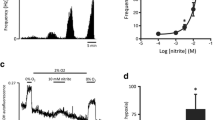Abstract
On thermodynamic grounds the mitochondrial redox catalysts are likely to be oxidized by molecular oxygen. Accordingly, their rates of auto-oxidation are enhanced by increasing oxygen pressure, generating oxygen radicals. These radicals are ordinarily removed by the protective enzymes such as Superoxide dismutase. Overproduction of the naturally occuring oxygen radicals during hyperoxia can overwhelm the enzymatic removal systems, resulting in a net accumulation of these free radicals (Fridovitch, 1983). Since oxygen chemoreception in the peripheral chemoreceptors depends on a reaction or interaction with oxygen, and since the chemosensory discharge continues to be suppressed by PO2 increases even in the hyperoxic range, we hypothesised that the chemoreceptor tissue may be specifically sensitive to oxygen radicals.
Access this chapter
Tax calculation will be finalised at checkout
Purchases are for personal use only
Preview
Unable to display preview. Download preview PDF.
Similar content being viewed by others
References
Fridovitch, I. (1983). Ann. Rev. Pharmacol. Toxicol., 23: 239–257.
Lahiri, S. and Delaney, R.G. (1975). Respir. Physiol. 24: 249–266.
Lahipi, S., Mulligan, E. and Mokashi, A. (1982). Brain Res., 234: 367–382.
Lahiri, S., Mokashi, A. and Mulligan, E. (1984). J.Physiol. London 358: 93P.
Mulligan, E. and Lahiri, S. (1982). Am. J. Physiol. 242 (Cell Physiol. 11), C200–C206.
Fisher, A.B. and Forman, H.J. (1985). In, Handbook of Physiology, Respiratory System, Vol. 1, Am. Physiol. Soc., Bethesda, Maryland, pp. 321–254.
Author information
Authors and Affiliations
Editor information
Editors and Affiliations
Rights and permissions
Copyright information
© 1987 J.A. Ribeiro and David J. Pallot
About this chapter
Cite this chapter
Lahiri, S., Mulligan, E., Mokashi, A., Andronikou, S., Shirahata, M. (1987). Altered Function of Cat Carotid Body Chemoreceptors in Prolonged Hyperoxia. In: Ribeiro, J.A., Pallot, D.J. (eds) Chemoreceptors in Respiratory Control. Springer, Dordrecht. https://doi.org/10.1007/978-94-015-1155-1_6
Download citation
DOI: https://doi.org/10.1007/978-94-015-1155-1_6
Publisher Name: Springer, Dordrecht
Print ISBN: 978-94-015-1157-5
Online ISBN: 978-94-015-1155-1
eBook Packages: Springer Book Archive



